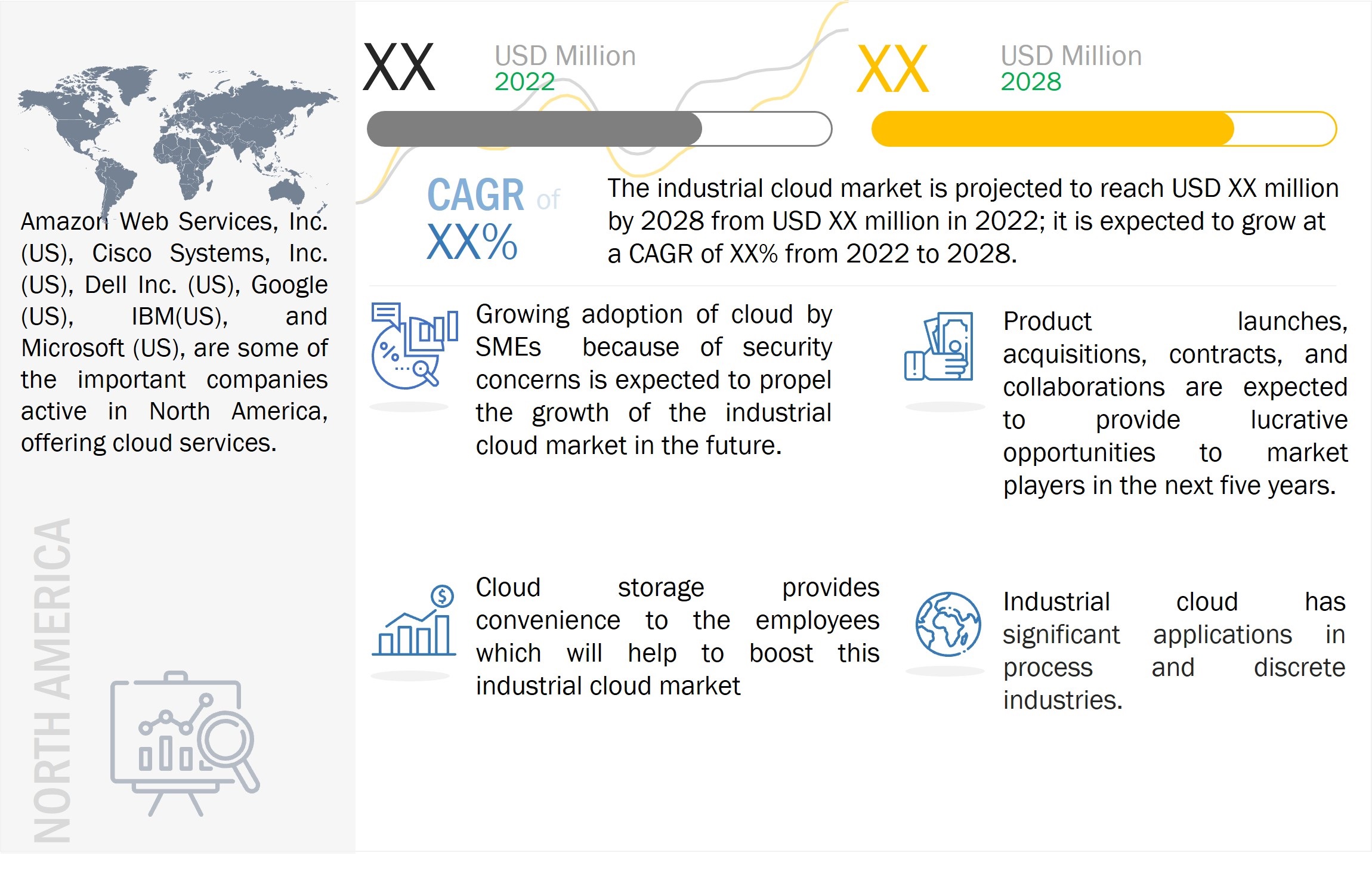Industrial Cloud Market by Type (PAAS, IAAS, SAAS), Cloud Type (Public, Private, and Hybrid Cloud), Application (Asset, Enterprise Resource, Customer Relationship, Supply Chain and Project Management) - Global Forecast to 2030
The industrial cloud provides an infrastructure solution so that it becomes easier to transmit data for applications mainly used on computers and mobile devices. With the industrial cloud, organizations can easily capture more data and use it to manage overall operations and assets strategically. Industrial cloud technology is widely used in asset-intensive industries such as manufacturing, transportation, mining, food & beverages, automotive, and energy generation/distribution.
The global industrial cloud market size is expected to grow from USD XX million in 2024 to USD XX million by 2030, at a CAGR of XX%. The key factors boosting market growth are the increasing demand for resource utilization and the growing demand for cloud services in various processes and discrete industries.

To know about the assumptions considered for the study, Request for Free Sample Report
Drivers: Rising adoption of the cloud by small and medium-sized enterprises
For small and medium-sized enterprises (SMEs), the industrial cloud provides a smarter and leaner technology option that helps to limit cost and increase productivity multiple times. In addition, the cloud offers many benefits to SMEs, such as reduced downtime, improved data security, CRM management, flexible storage, resource optimization, and remote computing. For instance, cloud technology helps increase the company's data security levels. Moreover, an additional advantage of this cloud technology is that the data is always backed-up.
Cloud storage offers convenience to employees
With the growing advancements and technological developments, businesses and the workforce are now becoming more mobile in nature. In companies, employees need to access and share files when working outside the office. And owing to the cloud-based storage facility, users can easily access the files wherever they are located.
Challenges: Lack of expertise or resources
One of the most critical challenges with the cloud is that companies currently face a risk of resource and expertise crunch. With the growing adoption trend of cloud technology, various companies are increasingly placing more workloads on the system. Cloud technology will continue to advance in the coming years rapidly. Because of these factors, companies face a tough time keeping up with the tools, and the need for expertise is also growing continuously. In addition, these challenges can be minimized by providing additional training to IT and development staff.
Key Market Players:
Amazon Web Services, Inc. (US), Cisco Systems, Inc. (US), Dell Inc. (US), Google (US), IBM (US), Microsoft (US), Honeywell International Inc. (US), and Siemens (Germany ) are few key players in the industrial cloud market globally.
- In June 2022, Cisco Systems, Inc. launched AppDynamics Cloud, a cloud-native observability platform mainly used for modern applications based on increasingly complex, distributed architectures and services.
- In December 2021, Amazon launched AWS GovCloud (US) Regions. This expansion into the AWS GovCloud (US) Regions helps US government agencies and contractors transfer their sensitive workloads onto AWS Outposts to meet their regulatory and compliance requirements for object storage.
- In October 2021, Alibaba Co., Ltd. launched a new server chip to boost its cloud computing business. Alibaba Co., Ltd.’s cloud computing clients will be able to buy services based on the latest technology. These servers are designed for artificial intelligence applications and storage.
To speak to our analyst for a discussion on the above findings, click Speak to Analyst

TABLE OF CONTENTS
1 Introduction
1.1. Study Objective
1.2. Market Definition
1.3. Market Scope
1.3.1. Markets Covered
1.3.2. Geographic Scope
1.3.3. Years considered for the study
1.4. Currency
1.5. Limitations
1.6. Market Stakeholders
2 Research Methodology
2.1. Research Data
2.1.1. Secondary and Primary Research
2.1.2. Secondar Data
2.1.3. Primary Data
2.2. Market Size Estimation
2.2.1. Bottom-up Approach
2.2.2. Top-down Approach
2.3. Data Triangulation
2.4. Research Assumptions
2.5. Risk Assessment
3 Executive Summary
4 Premium Insights
5 Market Overview
5.1. Introduction
5.2. Market Dynamics
5.2.1. Drivers
5.2.2. Restraints
5.2.3. Opportunities
5.2.4. Challenges
5.3. Value Chain Analysis
5.4. Ecosystem
5.5. Pricing Analysis
5.5.1. Average Selling Prices (ASP) of Key Players
5.5.2. Average Selling Prices (ASP) Trend
5.6. Trends/Disruptions Impacting Customers
5.7. Technology Analysis
5.8. Porter’s Five Forces Analysis
5.9. Key Stakeholders & Buying Criteria
5.9.1. Key Stakeholders in Buying Process
5.9.2. Buying Criteria
5.10. Case Study
5.11. Trade Analysis
5.12. Patents Analysis
5.13. Key Conferences & Events
5.14. Tariff and Regulatory Landscape
5.14.1. Regulatory Bodies, Government Agencies, and Other Organizations
5.14.2. Regulations and Standards
6 Industrial Cloud Market, By Type
6.1. Introduction
6.2. PAAS
6.3. IAAS
6.4. SAAS
7 Industrial Cloud Market, By Cloud Type
7.1. Introduction
7.2. Public Cloud
7.3. Private Cloud
7.4. Hybrid Cloud
8 Industrial Cloud Market, By Application
8.1. Introduction
8.2. Asset Management
8.3. Enterprise Resource Management
8.4. Customer Relationship Management
8.5. Supply Chain Management
8.6. Project and Portfolio Management
8.7. Others
9 Industrial Cloud Market, By Industry
9.1. Introduction
9.2. Process
9.3. Discrete
10 Industrial Cloud Market, By Region
10.1. Introduction
10.2. North America
10.3. Europe
10.4. Asia Pacific
10.5. RoW
11 Competitive Landscape
11.1. Introduction
11.2. Key Player Strategies/ Right to Win
11.3. Top 5 Company Revenue Analysis
11.4. Market Share Analysis
11.5. Company Evaluation Quadrant
11.5.1. Star
11.5.2. Emerging Leader
11.5.3. Pervasive
11.5.4. Participant
11.6. Startup/SME Evaluation Matrix
11.6.1. Progressive Companies
11.6.2. Responsive Companies
11.6.3. Dynamic Companies
11.6.4. Starting Blocks
11.7. Industrial Cloud Market: Company Footprint
11.8. Competitive Benchmarking
11.9. Competitive Situation and Trends
12 Company Profiles
12.1. Introduction
12.2. Key Players
12.2.1. Alibaba (China) Co., Ltd.
12.2.2. Amazon Web Services, Inc.
12.2.3. Cisco Systems, Inc.
12.2.4. Dell Inc.
12.2.5. Google
12.2.6. IBM
12.2.7. Microsoft
12.2.8. Honeywell International Inc.
12.2.9. Siemens
12.2.10. Oracle
12.2.11. HP Development Company, L.P.
12.2.12. General Electric Company
12.2.13. Hitachi, Ltd.
12.2.14. PTC Inc.
12.2.15. Rockwell Automation, Inc.
13 Adjacent & Related Market
14 Appendix















Growth opportunities and latent adjacency in Industrial Cloud Market